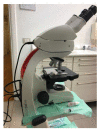Efficacy of Home Oral-Hygiene Protocols during Orthodontic Treatment with Multibrackets and Clear Aligners: Microbiological Analysis with Phase-Contrast Microscope
- PMID: 36360596
- PMCID: PMC9691180
- DOI: 10.3390/healthcare10112255
Efficacy of Home Oral-Hygiene Protocols during Orthodontic Treatment with Multibrackets and Clear Aligners: Microbiological Analysis with Phase-Contrast Microscope
Abstract
The purpose of this study is to analyze the microbiota of patients undergoing orthodontic treatment with multibrackets and transparent aligners. The second goal is to evaluate the effectiveness of the oral irrigator on the oral hygiene and periodontal health of orthodontic patients. Fifty patients (27 F, 23 M; mean age 21.5 years) were recruited for the study, then divided into two groups. Group A underwent fixed orthodontic therapy with multibracket, and a home protocol that included manual orthodontic toothbrush, interdental brushes, and one-tuft brushes. Group B used transparent aligners for 22 h a day and a home protocol that included a manual brush with soft bristles and dental floss. After 3 months, all patients of the two groups, A and B, underwent plaque evaluation with a phase-contrast microscope. If the test result showed non-pathogenic bacterial flora, the subject continued with the traditional home oral-hygiene protocol. If the test detected pathogenic flora, the subject changed the home protocol, with a sonic toothbrush and oral irrigator, while the microbiological analysis continued to be performed after 3 months. After 3 months, 10 out of 25 patients treated with multibrackets (group A) and only 3 out of 25 patients with aligners (group B) passed from non-pathogenic flora to pathogenic flora. After 6 months, using the oral irrigator and a sonic toothbrush for 3 months, all subjects returned to non-pathogenic flora. This study confirms that in patients treated with multibrackets, the risk of developing unfavorable microbiota increases compared to those treated with clear aligners. The use of an oral irrigator combined with the sonic toothbrush seems to be able to restore good oral hygiene in subjects with pathogenic flora and therefore to be effective at reducing the risk of caries and gingivitis in orthodontic patients.
Keywords: clear aligners; microbiological analysis; multibrackets; oral hygiene; oral irrigator; oral prevention; orthodontics; phase-contrast microscope.
Conflict of interest statement
The authors declare no conflict of interest.
Figures










Similar articles
-
Home Biofilm Management in Orthodontic Aligners: A Systematic Review.Dent J (Basel). 2024 Oct 21;12(10):335. doi: 10.3390/dj12100335. Dent J (Basel). 2024. PMID: 39452463 Free PMC article. Review.
-
The Effects of Use of a Powered and a Manual Home Oral Hygiene Regimen on Plaque and Gum Health in an Orthodontic Population.J Clin Dent. 2019 Mar;30(Spec No A):A1-8. J Clin Dent. 2019. PMID: 30964968 Clinical Trial.
-
Comparison of Effectiveness of Manual Orthodontic, Powered and Sonic Toothbrushes on Oral Hygiene of Fixed Orthodontic Patients.Int J Clin Pediatr Dent. 2015 Sep-Dec;8(3):181-9. doi: 10.5005/jp-journals-10005-1310. Epub 2015 Sep 11. Int J Clin Pediatr Dent. 2015. PMID: 26628852 Free PMC article.
-
Plaque and gingivitis reduction in patients undergoing orthodontic treatment with fixed appliances-comparison of toothbrushes and interdental cleaning aids. A 6-month clinical single-blind trial.J Orofac Orthop. 2005 Jan;66(1):20-38. doi: 10.1007/s00056-005-0344-4. J Orofac Orthop. 2005. PMID: 15711898 Clinical Trial. English, German.
-
Effects of Multibracket Orthodontic Treatment versus Clear Aligners on Periodontal Health: An Integrative Review.Dent J (Basel). 2022 Sep 21;10(10):177. doi: 10.3390/dj10100177. Dent J (Basel). 2022. PMID: 36285987 Free PMC article. Review.
Cited by
-
The effectiveness of water jet flossing and interdental flossing for oral hygiene in orthodontic patients with fixed appliances: a randomized clinical trial.BMC Oral Health. 2024 Apr 27;24(1):498. doi: 10.1186/s12903-024-04166-0. BMC Oral Health. 2024. PMID: 38678246 Free PMC article. Clinical Trial.
-
Changes in the Oral Microbiota with the Use of Aligners vs. Braces: A Systematic Review.J Clin Med. 2024 Dec 6;13(23):7435. doi: 10.3390/jcm13237435. J Clin Med. 2024. PMID: 39685893 Free PMC article. Review.
-
Home Biofilm Management in Orthodontic Aligners: A Systematic Review.Dent J (Basel). 2024 Oct 21;12(10):335. doi: 10.3390/dj12100335. Dent J (Basel). 2024. PMID: 39452463 Free PMC article. Review.
-
Dynamics of the oral microbiome during orthodontic treatment and antimicrobial advances for orthodontic appliances.iScience. 2024 Nov 22;27(12):111458. doi: 10.1016/j.isci.2024.111458. eCollection 2024 Dec 20. iScience. 2024. PMID: 39720528 Free PMC article. Review.
-
Time-dependent microbiome dynamics in orthodontic thermoplastic materials: comparing PETG and TPU.Clin Oral Investig. 2025 Jul 8;29(8):374. doi: 10.1007/s00784-025-06441-y. Clin Oral Investig. 2025. PMID: 40624404 Free PMC article.
References
LinkOut - more resources
Full Text Sources

